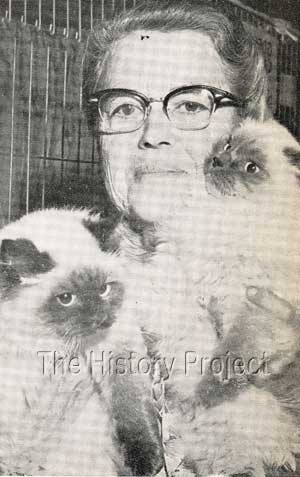 | ||









|
LONGHAIR/ANGORA/PERSIAN - COLORPOINT / HIMALAYAN
As early as 1924, there was a published report in the Journal of Genetics about a hybrid breeding program conducted by K. Tjebbes of Holland, who wrote, "The greater part of my cats are the offspring of a cross between white Persian and Siamese." In the mid-1930's, Mrs. Virginia Cobb and Dr. Clyde Keeler, who lived in the northeastern USA, began an experimental breeding program of Siamese to Persian with the ultimate goal to be a Persian style of cat with Siamese coloring. Mrs. Cobb's black Persian female, Susannah of Newton, was used in the program along with Mrs. Cobb's winning Siamese. Simultaneously, Mrs. Kathleen Barton Wright, founder of the New Experimental Breeder Association in England, was working on a similar program to produce a longhair Siamese. Mrs. Wright was working with Mrs. Gilfillan and Mrs. French and their advancements were pretty equal to those of Mrs. Cobb and Dr. Keeler. Unfortunately, the first longhair kittens from the outcrosses did not survive on either side of the Atlantic. Meanwhile, in Europe, the Swiss were also working on a hybridization program and managed to produce several hybrid Siamese-Persian kittens. In the May, 1937 edition of Our Cats, Mrs. Cobb announced the arrival of "another Long-Haired Siamese male kitten. He has been named Phya Tak" and that "he is hale and hearty right now." She obviously had additional success raising hybrid kittens, because in April of 1938 she wrote that, "My Siamese-Persian hybrid (long haired Siamese) is going to the Washington show, for exhibition only. Her name is Dux and more often called Duckee." Unfortunately, none of these early breeding programs seemed to generate a successive line of breeding cats, and they eventually discontinued the program. After World War II, Miss Collins of England "bred Color-Points experimentally with Siamese and Longhair Blue, Black and Cream about 1949. One of the first known Colour-points was of her breeding." The Colorpoint Longhair, as the pointed Persian is known in Britain, was recognized as a breed, number 13b, by the GCCF in 1955. Later, Mr. Brian Stirling-Webb took up the cause and successfully bred Colorpoint Longhairs under his Briarry cattery prefix, exporting several to North America. Mrs. S.M. Harding of the Mingchiu cattery worked with Mr. Sterling-Webb, and took in several of the cats upon his untimely passing. She exported many "Colorpoints" around the world, often sending breeding pairs to allow the breed to propser. Many Mingchiu cats can be found in the foundation pedigrees of numerous North American catteries. On the American side, the experimental breeding was taken up by Mrs. Margarita Goforth (pictured above), who had taken in Princess Himalayan Hope, a Siamese-Persian cross, and bred her to some of the finest Persian studs she could find to achieve more of a Persian body style than that of the Siamese. The ultimate goal was to have a Persian cat with only the coloration of the Siamese. In Canada, Ben and Ann Borrett established the Chestermere cattery with cats imported from Mr. Stirling-Webb and Mrs. Harding in England. They continued to use both Siamese and Persians in their development program. Whether the 'Himalayan', as the Color-Point Longhair is known on the American side of the Atlantic, should remain a separate breed or be considered a Persian was an argument that was in place from the early 1960's. In a letter to the editor of Cats Magazine, published in March 1966, Mrs. Borrett vehemently disagreed that the Himalayan should become known as a Persian, claiming that the policy would discourage new breeders. Mrs. Harvey Billig went so far as to claim "The Himalayan is not, and can never be, a Persian, but can be a very successful hybrid of great beauty." There were people who scoffed and said that the Himalayans would never be Persian type, and would never be competition for the other colors of Persians. Boy, were they wrong! GC Chestermere Kinuba of Nevah-Tep, a blue point male born in 1962, was CFA's first Himalayan Grand Champion, By the 1971-1972 show season, Himalayans were consistent finalists and GC, BW, NW Lord Byron, a seal point male, was CFA's 9th Best Cat. GC, BW, NW Nevah-Tep's Vogue, a seal point female, achieved 17th Best Cat in CFA during the 1974-1975 show season. Both Lord Byron and Vogue have pedigrees that trace back to Kinuba, and farther back can be found the original Briarry imports. After years of breedings to perfect the type and style of the Himalayan, CFA moved them from a breed of their own into a color division of the Persian breed in 1984. The Himalayans of today are stunning examples of the Persian breed, matching the other color divisions not only in body style but also head type. When a cream point Himalayan, GC, BW, NW Teahs McFlurry, finally achieved the CFA Best Cat award in the 2001-2002 show season, it was a hard-earned yet well-deserved win. The Best Cat win was repeated in the 2004-2005 show season by GC, BW, NW Catsafrats Tea Time, another cream point. COLORPOINT/HIMALAYAN LONGHAIR HISTORIES(* = completed histories)
Registers associated with this article include The Incorporated Cat Fanciers Association of Great Britain (TICFAGB), National Cat Club (NCC), The Cat Club (CCR), Beresford Cat Club (BCC), Feline Federation Francaise (FFF), Siamese Cat Registry (SCR), US Register & Studbook for Cats (USR)including Supplement(USRS), The Studbook of the American Cat Association (ACA), and the Studbook & Register of the Cat Fanciers' Association (CFA).
|
|
Home | Cats | Gallery | Clubs | People | Artifacts | Articles | Updates | Contact Us ©The CFA Foundation, Inc and The Harrison Weir Collection
|
||
